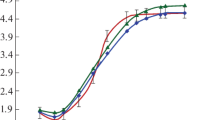An analytical model of the current–voltage characteristics of a thermionic energy converter is presented. The model was developed by comparing the results of numerical integration of the equations governing charge transport and energy transfer in the interelectrode gap with the experimental characteristics and diagnostics of the near-electrode plasma parameters and the emission properties of the electrodes. The computed and experimental characteristics are compared in a wide range of electrode temperatures, cesium vapor pressures, interelectrode gaps and electrode materials. The results confirm that the computed and experimental characteristics measured in converters with planar and cylindrical electrode geometries are not only in qualitative but also quantitative agreement with one another. The model can be used to calculate the parameters of nuclear thermionic power-generation facilities and to analyze the results of secondary-loop tests of electricity-generating channels.
Similar content being viewed by others
References
F. G. Baksht, G. A. Dyuzhev, I. L. Korobova, et al., “Low-voltage arc in thermionic converters,” Zh. Tekhn. Fiz., 38, No. 7, 1075–1094 (1968).
V. Z. Kaibyshev, Thermionic Emission in Space Nuclear Power Facilities, edited by N. N. Ponomarev-Stepnoi, Energoatomizdat, Moscow (2008).
V. Z. Kaibyshev, “Identification of the factors determining the efficiency of a thermionic energy converter,” At. Énerg., 112, No. 1, 24–31 (2012).
V. Z. Kaibyshev, “Identification of the factors determining TEC efficiency,” in: Int. Conf. Nuclear Power in Space 2005, Moscow–Podolsk, March 1–3, 2005, Vol. 2, pp. 320–331.
F. Rufeh and D. Lieb, The Output Characteristics of a Vapor-Deposited Tungsten Emitter and a Molybdenum Collector, Thermo Electron Corporation, Massachusetts, June 1969.
L. Hansen, “Criterion for a double sheath emission barrier,” in: Thermionic Conversion Specialist Conf., Carmel, California, October 1969, pp. 212–219.
F. G. Baksht, B. Ya. Moizhes, and V. A. Nemchinskii, “Ionization in plasma together with Maxwellization of the free electrons,” Zh. Tekhn. Fiz., 38, No. 10, 1731–1743 (1968).
D. Lieb, A. Donaker, and F. Rufeh, “Performance of a thermionic converter with a nominal single crystal (110) tungsten emitter and a niobium collector,” in: Thermionic Conversion Specialist Conf., Carmel, California, October 1969, pp. 66–75.
Author information
Authors and Affiliations
Additional information
Translated from Atomnaya Énergiya, Vol. 112, No. 5, pp. 270–276, May, 2012.
Rights and permissions
About this article
Cite this article
Kaibyshev, V.Z., Chebotarev, V.I. Analytical model for calculating the current–voltage characteristics of a thermionic energy converter. At Energy 112, 332–340 (2012). https://doi.org/10.1007/s10512-012-9566-x
Received:
Published:
Issue Date:
DOI: https://doi.org/10.1007/s10512-012-9566-x



